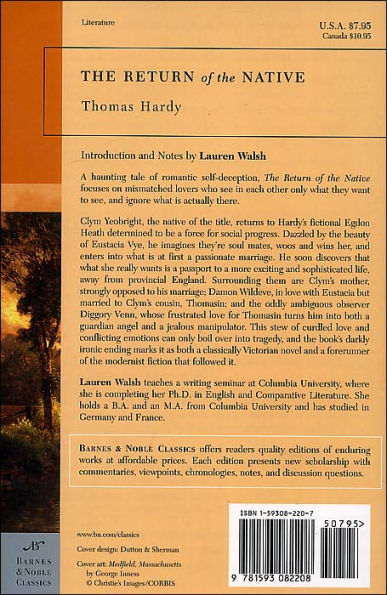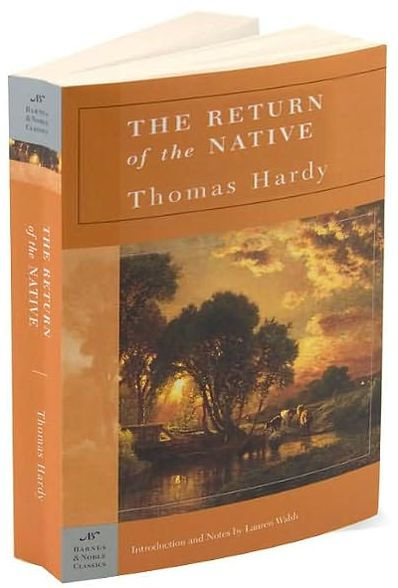- New introductions commissioned from today's top writers and scholars
- Biographies of the authors
- Chronologies of contemporary historical, biographical, and cultural events
- Footnotes and endnotes
- Selective discussions of imitations, parodies, poems, books, plays, paintings, operas, statuary, and films inspired by the work
- Comments by other famous authors
- Study questions to challenge the reader's viewpoints and expectations
- Bibliographies for further reading
- Indices & Glossaries, when appropriate
A haunting tale of romantic self-deception, The Return of the Native focuses on mismatched lovers who see in each other only what they want to see, and decidedly not what is actually there.
Clym Yeobright, the native of the title, returns to Hardy’s fictional Egdon Heath determined to be a force for social progress. Dazzled by the beauty of Eustacia Vye, he imagines they’re soul mates, woos and wins her, and enters into what is at first a passionate marriage. He soon discovers that what she really wants is a passport to a more exciting and sophisticated life, away from provincial England. Surrounding them are Clym’s mother, strongly opposed to his marriage; Damon Wildeve, in love with Eustacia but married to Clym’s cousin, Thomasin; and the oddly ambiguous observer Diggory Venn, whose frustrated love for Thomasin turns him into either a guardian angel or a jealous manipulator—or perhaps both. This stew of curdled love and conflicting emotions can only boil over into tragedy, and the book’s darkly ironic ending marks it as both a classically Victorian novel and a forerunner of the modernist fiction that followed it.
Lauren Walsh teaches a writing seminar at Columbia University, where she is completing her Ph.D. in English and Comparative Literature.
- New introductions commissioned from today's top writers and scholars
- Biographies of the authors
- Chronologies of contemporary historical, biographical, and cultural events
- Footnotes and endnotes
- Selective discussions of imitations, parodies, poems, books, plays, paintings, operas, statuary, and films inspired by the work
- Comments by other famous authors
- Study questions to challenge the reader's viewpoints and expectations
- Bibliographies for further reading
- Indices & Glossaries, when appropriate
A haunting tale of romantic self-deception, The Return of the Native focuses on mismatched lovers who see in each other only what they want to see, and decidedly not what is actually there.
Clym Yeobright, the native of the title, returns to Hardy’s fictional Egdon Heath determined to be a force for social progress. Dazzled by the beauty of Eustacia Vye, he imagines they’re soul mates, woos and wins her, and enters into what is at first a passionate marriage. He soon discovers that what she really wants is a passport to a more exciting and sophisticated life, away from provincial England. Surrounding them are Clym’s mother, strongly opposed to his marriage; Damon Wildeve, in love with Eustacia but married to Clym’s cousin, Thomasin; and the oddly ambiguous observer Diggory Venn, whose frustrated love for Thomasin turns him into either a guardian angel or a jealous manipulator—or perhaps both. This stew of curdled love and conflicting emotions can only boil over into tragedy, and the book’s darkly ironic ending marks it as both a classically Victorian novel and a forerunner of the modernist fiction that followed it.
Lauren Walsh teaches a writing seminar at Columbia University, where she is completing her Ph.D. in English and Comparative Literature.

The Return of the Native (Barnes & Noble Classics Series)
464
The Return of the Native (Barnes & Noble Classics Series)
464Related collections and offers

Product Details
| ISBN-13: | 9781593082208 |
|---|---|
| Publisher: | Barnes & Noble |
| Publication date: | 07/01/2005 |
| Series: | Barnes & Noble Classics Series |
| Pages: | 464 |
| Sales rank: | 21,693 |
| Product dimensions: | 7.88(w) x 5.30(h) x 1.26(d) |
About the Author
Customer Reviews
Explore More Items
At first glance, Three Lives seems to be three straightforward portraits of women living in the early twentieth century. “The Good Anna” describes an exacting German house servant;
Etched against the background of a dying rural society, Tess of the d'Urbervilles was Thomas Hardy's 'bestseller,' and Tess Durbeyfield remains his most striking and tragic heroine. Of all the
Etched against the background of a dying rural society, Tess of the d'Urbervilles was Thomas Hardy's 'bestseller,' and Tess Durbeyfield remains his most striking and tragic heroine. Of all the
The novel is set in impoverished rural Wessex during the Long Depression. Tess is the oldest child of John and Joan Durbeyfield, uneducated rural peasants. One day, Parson Tringham informs John that
HarperCollins is pround to present its new range of best-loved, essential classics.
'My life looks as if it had been wasted for want of chances! When I see what you know, what you have read, and seen,
Bathsheba Everdene arrives in the small village of Weatherbury and captures the heart of three very different men; Gabriel Oak, a quiet shepherd, the proud, obdurate Farmer Boldwood and dashing,





